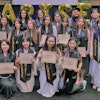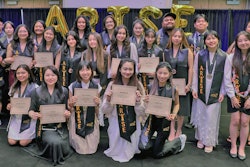One of the proudest accomplishments of my undergraduate experience was my involvement with the V-Day Movement that produces The Vagina Monologues every year. Freshman fall, I joined this organization whose mission is to “end violence against all women and girls (cisgender, transgender, and those who hold fluid identities that are subject to gender-based violence).” I loved performing, and ending sexual violence was an issue that I have always been passionate about, so V-Day and VagMons were the perfect fusion of those two interests.
After performing heavier monologues on topics of rape and revolution during my freshman and sophomore years, I was cast to perform “The Woman Who Loved to Make Vaginas Happy” in my junior year. We all called it “The Moaner” for short. This piece was figuratively and literally the climax of the show in which the narrator, a self-described “sex worker who only had sex with women,” discussed her love for moaning and making other women moan. The piece culminated in an over-the-top “triple orgasm moan.”
I never considered myself to be an overtly sexual person. On the contrary, I was rather private and felt uncomfortable in my own skin. The idea of very vocally simulating orgasms on stage was terrifying enough, but to do that confidently while over a thousand people watched was unimaginable. I nearly dropped out of the role on multiple occasions. I had to collect myself and recall why I was involved in the organization to begin with.
I was a part of V-Day to end gender-based violence. That meant educating people on issues of consent. It meant advocating for survivors. For me, it also meant implementing different aspects of my identity to purposefully act as an agent of change. The intersection of two of my most salient identities—being Asian American and a woman—was never satisfactorily depicted in American culture.
In fact, I was exhausted by the lack of representation of Asian Americans in the media. I was frustrated that in the rare instances where Asian women were represented, they had nameless roles and were portrayed as temporary, submissive love interests to ultimately remind the male protagonist that his true love was his quirky, White childhood best friend. Otherwise, they were hypersexualized as geishas or prostitues or the exotic foreign exchange student. In nearly all situations, Asian women had no agency over their own sexuality, regardless of what end of the spectrum they were on. My frustration with this fetishization and objectification finally trumped my personal fears and discomfort.
I knew that being on that stage as an Asian American woman who was in complete control of her sexuality was something that people needed to see. This was an opportunity, a platform, to portray an empowered woman who was not encumbered by the male gaze. I felt the need to perform the piece because no Asian American woman had ever performed it at my school. So, in front of a thousand people, I moaned. The response I received was incredibly affirming and rewarding.
The following year, I was the director of the show. While anyone can be a part of the V-Day, the number of performing roles was limited. I made it clear to my producer that acting ability was a lower priority when casting roles. It was much more important to hear why someone wanted to be a part of V-Day and what the Movement meant to them. Thankfully, I was working with an amazing producer who was on the same page. Our casting choices were deliberate, especially because we knew that VagMons has a history of being a predominantly cis, White space.















